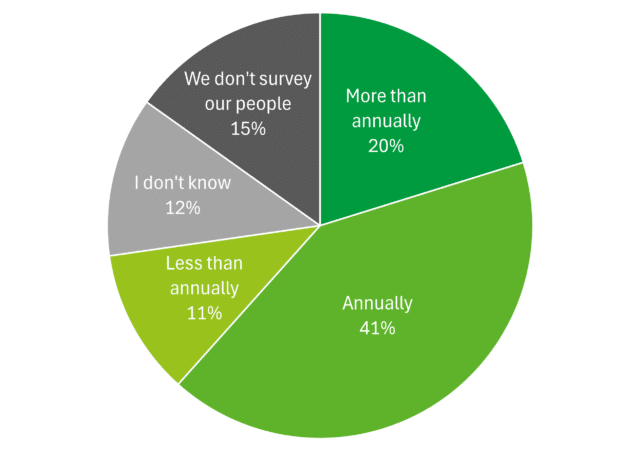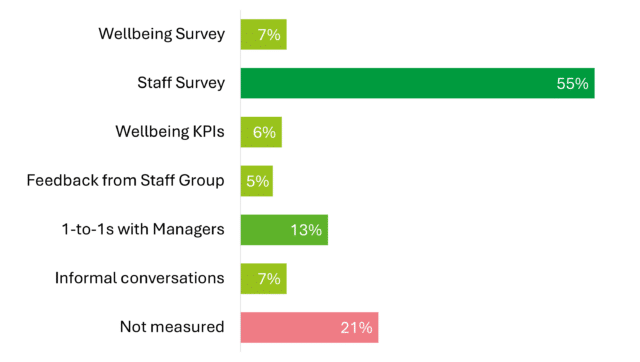
Insights
Helping not-for-profit organisations develop and sustain
the highest levels of employee and volunteer engagement

Insights

Although we tend to work with clients in HR roles, the survey revealed that, for 29% of respondents, Internal Comms is responsible for staff surveys, and for a further 12% the survey is managed by whichever team needs it done.
In our experience internal comms colleagues have a fundamental role to play in the success of any people survey:
We have also seen an increasing number of instances where internal comms take on the lead role in delivering employee and volunteer listening programs. This feels like a natural fit as a survey is after all a key form of communication to the organisation, from its people.
The questions we included in the CharityComms survey go further in telling us how different organisations are approaching employee feedback – and how important that feedback is.
 How frequently are people in your organisation surveyed about their employee experience?
How frequently are people in your organisation surveyed about their employee experience?Most commonly, respondents said their organisation surveys its people once a year. About half as many said they do surveys more often (monthly, quarterly or six monthly), and 11% said they gather this kind of feedback every two years or less frequently.
15% of respondents said that people in their organisation aren’t surveyed about their employee experience.
We have seen a marked increase in frequency of surveying amongst non-profit organisations in recent years. Many organisations are incorporating pulse surveys to stay in touch with staff views and how initiatives are landing. This is driven by an increased appetite for feedback and pace of change, as well as technology advances making it easier to gather frequent feedback.
There is no single ‘best’ model – each organisation will wish to consider what survey frequency meets their needs and matches their capacity to engage with the feedback received.
In those organisations that are gathering employee feedback, the most common approach (38% of respondents) was to share survey results in full with all staff.
The next most common outcomes were for only headline results to be shared with all staff, or full results to be shared with managers, who are encouraged to discuss them with their teams.
In a small number of organisations, only senior leaders see the results, or results are shared with managers but not with all staff.
18% weren’t sure how their survey results are shared.
There is a lot to be said for transparency. Your people have taken the time to share their views and experiences – people will be interested in the results, and perhaps deserve to see them, regardless of whether they are ‘good’, ‘bad’ or somewhere in the middle.
Sharing the results with everyone is a great opportunity to show openness, to demonstrate a commitment to listening and to trigger informed discussion across the organisation.
Each organisation will need to think through how far they wish to extend transparency. In our view, sharing the global results, in full, with all staff is good practice. Similarly, sharing results for particular parts of the organisation with those parts is also important, to empower them to engage with their own specific results and map out suitable actions.

We know that more and more organisations are focusing on employee wellbeing, and understanding how your people are feeling is crucial to taking the right steps to support them.
13% of respondents said that staff wellbeing levels were picked up through one-to-one meetings with managers, and a few respondents said that wellbeing could be openly discussed in informal conversations or through a staff group.
2 in 10 respondents said that wellbeing is not currently measured in their organisation. If your organisation is looking to start measuring employee wellbeing, our guide is a good place to start: ‘Measuring, understanding and improving the wellbeing and mental health of your people’.
About a third of respondents to this question felt that employee feedback is not important to their organisation. Either staff feedback is not frequently gathered, or the feedback given does not seem to translate into actions. It’s not unusual for organisations that are just starting to gather employee feedback to struggle with taking action – we know the hardest part of running an employee survey is what comes next. Here are our 5 recommended stages for effective action planning.
However, many respondents shared that feedback from employees – gathered with a staff survey, one-to-ones, working groups or other consultation approaches – has been crucial in inspiring change. Two key ways were in shaping action plans and strategies, and making concrete changes that staff suggested. It is encouraging that many organisations are taking action on employee feedback. For advise on making your action planning processes more impactful, download our free guide.
Respondents told us that feedback from staff is shared directly with senior leaders and managers, and used to develop action plans tailored to each part of the organisation. As well as these departmental/directorate action plans, feedback is fed into the development of key policies, plans and strategies that shape organisational culture.
“Managers are encouraged to use feedback to create improvements at local, regional and national level.”
“Employee feedback led to an antiracism programme and a draft wellbeing policy.”
“Reviewed by Leadership Team who develop a draft plan. This is shared with all staff for input, adjusted and then implemented. In the past two years we have seen the internal comms satisfaction score rise from below 20% (2021) to c.70% (2022).”
For some organisations, employee feedback has pointed to clear solutions. When actions are taken directly because of feedback, the cycle of employee listening is strengthened. “You said, we did” can be a powerful tool to move organisations towards a more inclusive and understanding culture.
“Comments and experiences about workload and wellbeing have led to the actions taken to improve employee benefits, wellbeing resources and acknowledgement that project management and training is essential.”
“Some aspects of organisational culture are revealed in staff surveys and arrangements put in place to implement changes. For example, the lack of employee recognition was highlighted in a survey. There is now an employee recognition scheme.”
“For example, we’re in the process of introducing a new values and behaviours framework. Part of communicating this will involve linking how the new framework takes on board feedback from the survey.”
Do these findings resonate with how your organisation is gathering employee feedback? Get in touch to speak to a survey expert at Agenda about developing your employee survey approach.
Author
James Gurd, Senior Research Consultant
5 Linford Forum
Rockingham Drive
Milton Keynes
MK14 6LY
UK
Company No: 4509427
